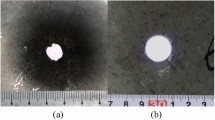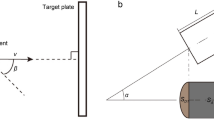Abstract
In present study, simulation results of tungsten penetrator are compared with the experimental results in order to confirm the predictions for residual velocity. The cylindrical tungsten penetrator with conical tip and flat tip were used for the experiment and simulation. The metal target material were made of SM 20C, titanium and aluminum. The dimension of the target was 100 × 100 × 5 (mm3). The range of initial velocity was from 400 to 1500 m/s. AUTODYN-3D simulation was used to study the perforation effect of penetrator. The simulation results were confirmed with experimental results within 10%. The assessment accuracy was achieved by applying the erosion value.
Similar content being viewed by others
References
Ballistic Analysis laboratory, Johs-Hopkins University, Baltimore, The resistance of various metallic materials to perforation by steel fragments. Thor TR No.51, Confidential (1963).
E. Wollmann, K. Hoog, G. Koerber and B. Wellige, Performance of Ballistic terminal performance at incidence, R1:10/96 (1996).
J. H. Jo, Y. S. Lee, J. H. Kim and Y. W. Bae, Study of hypervelocity penetration characteristics of segmented tungsten penetrator, Trans of KSME series A, 37 (8) (2013) 953–960.
J. H. Jo, Y. S. Lee, J. H. Kim and Y. W. Bae, Study on penetration characteristics of tungsten cylindrical penetrator, Trans of KSME series A, 37 (9) (2013) 1083–1091.
Y. S. Lee, C. H. Ryu, H. S. Kim and Y. J. Choi, A study on the free drop impact of a cask using commercial FEA cods, Nuclear Engineering and Design, 235 (2005) 2219–2226.
C. H. Chung and S. Y. Kim, Local and aircraft impact on the nuclear power plant structures, Journal of Korea Society of Civil Engineers, Korea (2011) 18–26.
www.ansys.com.Ansys/Autodyn-3d.:12.1 User’s manual, Material models chapter (2011).
The resistance of various non-metallic materials to perforation by steel fragment; empirical relationships for fragments residual velocity and residual weight, Project Thor TR No. 47 (1961).
The resistance of various non-metallic materials to perforation by steel fragment; empirical relationships for fragments residual velocity and residual weight, Project Thor TR No. 51 (1961).
I. M. Kamal and E. M. Eltehewy, Projectile penetration of reinforced concrete blocks: Test and analysis, Theoretical and Applied Fracture Mechanics, 60 (2012) 31–37.
J. Dean, C. S. Dunleavy, P. M. Brown and T. W. Clyne, Energy absorption during projectile perforation of thin steel plates and the kinetic energy of ejected fragments, International Journal of Impact Engineering, 36 (2009) 1250–1258.
N. K. Gupta, M. A. Iqbal and G. S. Sekhon, Experimental and numerical studies on the behavior of thin aluminum plates subjected to impact by blunt and hemispherical-nosed projectiles, International Journal of Impact Engineering, 38 (2006) 1921–1944.
T. Borvik, O. S. Hopperstad, T. Berstad and M. Langseth, Numerical simulation of plugging failure in ballistic penetration, International Journal of Solids Structures, 38 (2001) 6241–6264.
Author information
Authors and Affiliations
Corresponding author
Additional information
This paper was presented at the FEOFS 2013, Jeju, Korea, June 9–13, 2013. Recommended by Guest Editor Jung-Il Song
Sangwon Lee received a B.S. degree in Automotive Engineering from Woosuk University, Korea in 2007. He recevied master degree in Mechanical Design Engineering at Chungnam National University, Korea in 2014. His research interests are in area of impact mechanics, penetration and FSI (fluid structure interaction).
YoungShin Lee received a B.S. degree in Mechanical Engineering from Yonsei University, Korea in 1972. He received master and Ph.D. in Mechanical Engineering from Yonsei University, Korea in 1974 and 1980, respectively. He is currently professor of Department of Mechanical Design Engineering at Chungnam National University, Korea. Prof. Lee’s research interests are in area of impact mechanics, optimal design, biomechanical analysis and shell structure analysis.
Rights and permissions
About this article
Cite this article
Lee, S., Yang, T., Lee, Y. et al. A study on perforation prediction of metal targets by cylindrical tungsten penetrator. J Mech Sci Technol 29, 115–120 (2015). https://doi.org/10.1007/s12206-014-1218-8
Received:
Revised:
Accepted:
Published:
Issue Date:
DOI: https://doi.org/10.1007/s12206-014-1218-8




